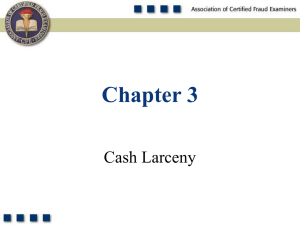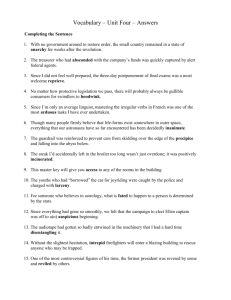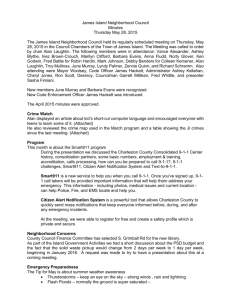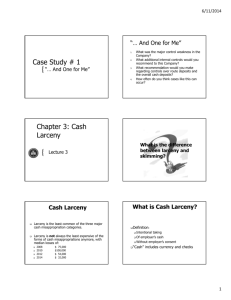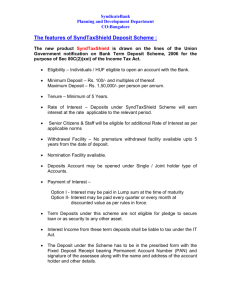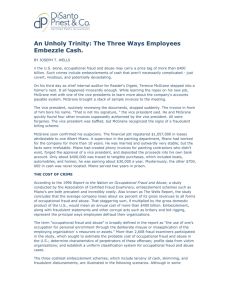2004 ACFE Post
advertisement
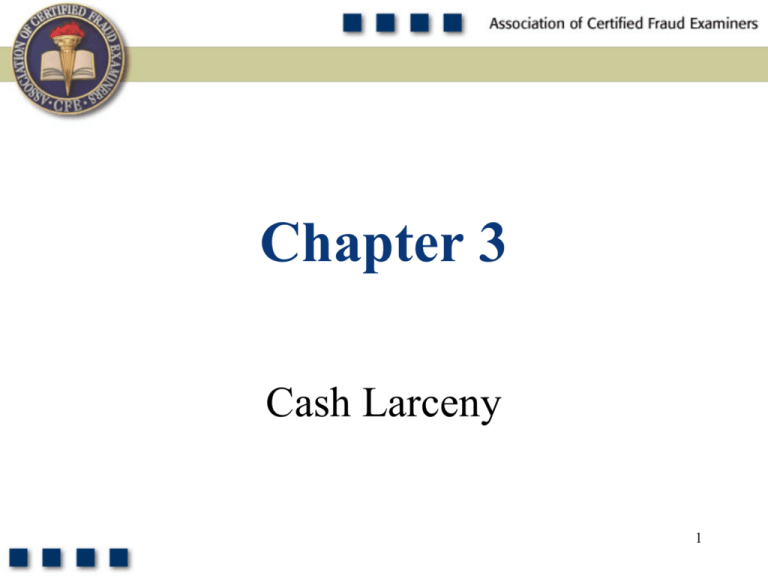
Chapter 3 Cash Larceny 1 Pop Quiz What is the difference between larceny and skimming? 2 Learning Objectives • Define cash larceny. • Understand how cash receipts schemes differ from fraudulent disbursements. • Recognize the difference between cash larceny and skimming. • Understand the relative frequency and cost of cash larceny schemes as opposed to other forms of cash misappropriations. • Identify weaknesses in internal controls as inducing factors to cash larceny schemes. • Understand how cash larceny is committed at the point of sale. 3 Learning Objectives • Discuss measures that can be used to prevent and detect cash larceny at the point of sale. • Understand and identify various methods used by fraudsters to conceal cash larceny of receivables. • Understand schemes involving cash larceny from deposits including lapping and deposits in transit. • Understand controls and procedures that can be used to prevent and detect cash larceny from bank deposits. • Be familiar with proactive audit tests that can be used to detect cash larceny schemes. 4 Larceny Of Cash on Hand From the Deposit Other 5 Cash Larceny • Intentional taking away of an employer’s cash without the consent and against the will of the employer • Fraudulent disbursements • Cash receipt schemes 6 Frequency – Cash Misappropriations Fraudulent Disbursements 65.2% Skimming 20.5% Cash Larceny 15.4% 0% 20% 40% 60% Percent of Cash Schemes 80% 7 Median Loss – Cash Misappropriations Fraudulent Disbursements $100,000 Skimming $58,000 Cash Larceny $54,000 $0 $20,000 $40,000 $60,000 $80,000 $100,000 $120,000 Median Loss 8 Cash Larceny Schemes • Can occur under any circumstance in which an employee has access to cash – At the point of sale – From incoming receivables – From the victim organization’s bank deposits 9 Larceny at The Point of Sale • It’s where the money is • Most common point of access to ready cash • Results in an imbalance between the register tape and cash drawer 10 Larceny Schemes • Theft from other registers – Using another cashier’s register or access code • Death by a thousand cuts – Stealing small amounts over an extended period of time • Reversing transactions – Using false voids or refunds – Causes the cash register tape to balance to the cash drawer • Altering cash counts or cash register tapes • Destroying register tapes 11 Preventing and Detecting Cash Larceny at the Point of Sale • Enforce separation of duties • Independent checks over the receipting and recording of incoming cash • Upon reconciliation of cash and register tape, cash should go directly to the cashier’s office • Discrepancies should be checked, especially if a pattern is identified • Periodically run reports showing discounts, returns, adjustments, and write-offs by employee, department, and location to identify unusual patterns 12 Larceny of Receivables • Theft occurs after the payment has been recorded • Force balancing – Having total control of the accounting system can overcome the problem of out-of-balance accounts – Can make unsupported entries in the books to produce a fictitious balance between receipts and ledgers • Reversing entries – Post the payment and then reverse the entry through “discounts” • Destruction of records – Destroying the records can conceal the identity of the perpetrator even though the fraud has been discovered 13 Cash Larceny From The Deposit • Whoever takes the deposit to the bank has an opportunity to steal a portion of it • Having controls—such as matching the receipted deposit slip to the originally prepared slip—does not always prevent theft • Failure to reconcile the slips can foster an environment leading to theft • Lack of security over the deposit before it goes to the bank can also lead to theft 14 Cash Larceny From The Deposit • Deposit lapping – Day one’s deposit is stolen and is replaced by day two’s deposit . . . . • Deposits in transit – The missing money is carried as a deposit in transit but it never clears the bank statement 15 Preventing and Detecting Cash Larceny From The Deposit • Separation of duties is the most important factor • All incoming revenues should be delivered to a centralized department • Compare the authenticated deposit slip with the company’s copy of the deposit slip, the remittance list, and the general ledger posting of the day’s receipts • Two copies of the bank statement should be delivered to different persons in the organization • Require that deposits be made at a night drop at the bank 16

